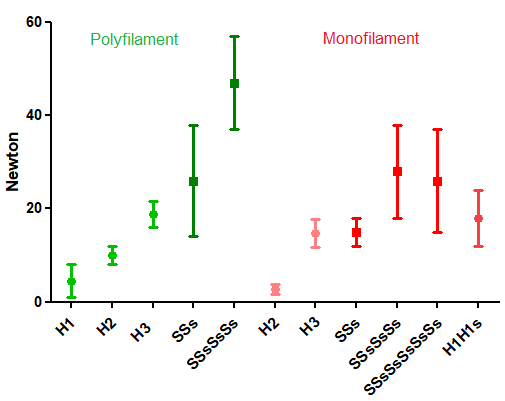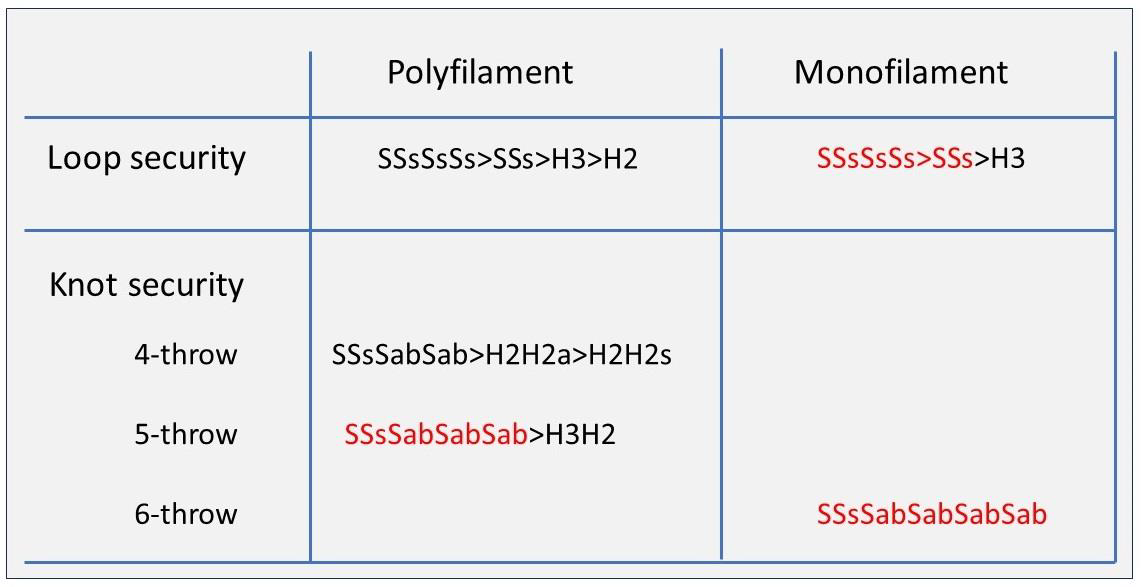Surgical knots are sequences of half-knots (H) or half-hitches (S), defined by their number of throws, by an opposite or similar rotation compared with the previous one, and for half-hitches whether they are sliding (s) or blocking (b). Opposite rotation results in (more secure) symmetric (s) knots, similar rotation in asymmetric (a) knots, and changing the active and passive ends has the same effect as changing the rotation. Loop security is the force to keep tissue together after a first half-knot or sliding half-hitches. With polyfilament sutures, H2, H3, SSs, and SSsSsSs have a loop security of 10, 18, 28, and 48 Newton (N), respectively. With monofilament sutures, they are only 7, 16, 18, and 25 N.
1. Knots Are Sequences of Half-Knots and Half-Hitches
In surgery, most knots (for an overview [
7]) are sequences of half-hitches (S) or half-knots (H) (
Figure 1) Half-hitches result from pulling one end of the suture, called the passive end. Half-knots (H) require symmetrical pulling of both ends. Half-knots are easily converted into half-hitches and vice-versa.
Figure 1. Symmetric and asymmetric Half-knots are easily changed into half-hitches. Three symmetrical half-hitches remain in one plane. When the active and passive ends are changed for a blocking half-hitch, the asymmetric half-hitch becomes symmetric on the new passive end.
Half-hitches usually consist of one-throw and half-knots of one to three throws.
Besides the number of throws [
8], rotation is essential. Compared to the previous one, alternate rotation of the same active end improves clinically knot security [
8,
9,
10,
11,
12]. Half-knot sequences with alternate rotation result in a flat square knot, visually recognised as symmetrical [
9]. Half-hitch sequences with opposite rotation apply a stronger squeeze to the passive end, and both ends stay on the same side. Similar rotation generally results in less secure knots, with the poor granny knot resulting from two one-throw similar rotation half-knots, as an example.
It is important to realize that changing the active and passive ends, as performed in bimanual laparoscopic suturing [
13] and blocking half-hitches, is similar to changing the rotation [
14].
A different class of knots are cinch knots [
15,
16], which are complex sliding knots that can be blocked when in place, such as the Röder knot.
2. Nomenclature of Knots and Historical Perspective
The terminology or nomenclature of half-knots was described in 1976 [
17] and of half-hitches in 1984 [
12] (
Table 1). Half-knots were indicated as “H” and half-hitches as “S” for sliding, followed by the number of throws. For subsequent half-knots or half-hitches, the rotation compared to the previous one was indicated by an “=“ of “x” to indicate a symmetric or asymmetric knot sequence. This terminology felt confusing because “=“ is often called “similar” without specifying that it means an alternate rotation resulting in a symmetric knot and not a similar rotation. For half-hitches, blocking was indicated by // [
18].
Table 1. Knot sequences are indicated by their geometry. A flat square knot is symmetric and results from an alternate rotation of the same active end. A granny knot is asymmetric and results from a similar rotation of the same active end. Changing the active and passive ends has the same effect as changing the rotation. Knot sequences used to be indicated with = for symmetric (also called identical), X for asymmetric and // for blocking. We prefer a more intuitive indication, with the type of each half-knot (H) or hitch (S), followed by the type of knot, using “s” for symmetric (alternate rotation around the passive end or mono manual suturing) and “a” for asymmetric (similar rotation around the passive tread). For half-hitches, it is indicated whether they are sliding (s) or blocking (b) after changing active and passive ends. For half-hitches, the number of throws is not indicated since it is always one, and sliding is not indicated to avoid confusion with the “s” of symmetric. A two-throw half-hitch results from the transformation of a two-throw half-knot.
To avoid ambiguity, we prefer to emphasize rotation because this is what the surgeon does when tying knots [
8,
9,
19]. It is intuitive for the surgeon who has to decide the number of throws and the sense of rotation for each half-knot or half-hitch. Therefore, the H or S is followed by the number of throws and the knot structure, which can be symmetric “
s” or asymmetric “
a”, when the rotation of the same active thread compared to the previous one had been alternate or similar. For half-hitches, an “
s” is added for sliding and a “
b” for blocking after changing the active and passive ends. It should be clear that a second sliding half-hitch made with a similar rotation, or SSas, can be changed into a blocking half-hitch, or SSab, by pulling the active end. However, it should be equally clear that changing the active and passive ends has the same effect as changing the rotation and that SSab thus indicates a symmetric half-hitch on the new active end. However, for the surgeon, the rules are straightforward: always use alternate rotation for half-knots and sliding half-hitches. Only for blocking half-hitches should similar rotation be used. This terminology can be simplified by omitting the number of throws if one and the “s” if sliding to avoid confusion with the (s) of symmetric. The surgeon also should realise the difference between monomanual and bimanual suturing because similar rotation results in symmetric knots after changing the active and passive ends. Half-hitches remain sliding as long as the passive end remains the same. However, reorganization might block some sequences when six or more half-hitch sequences are used. To summarize, SSsSsbSab indicates a second symmetrical and sliding, a third symmetrical (alternate rotation) and blocking, and a fourth asymmetrical (similar rotation) and blocking half-hitch.
3. Testing and Definitions of Loop and Knot Security
The security of knots is mostly evaluated with a dynamometer increasing forces at a constant speed and measuring the force when a suture breaks or slides open. Dynamic testing of the security will not be discussed because it is not yet useful in gynecology.
Loop security or holding strength is the first aspect to consider when suturing [
20]. This is the force needed to open the first loop, which can be the first half-knot, one or more sliding half-hitches, a sliding granny knot [
21], or a cinch knot. Loop security keeps the tissues approximated or sutured arteries leakproof until additional half-knots or half-hitches are added, securing the knot. Loop security, thus, is essential for making tight knots. The importance of inadequate loop security is illustrated by the incidences of postoperative bleeding, which was reported as high as 4% to 10% after hysterectomy in animals [
22].
The definition of knot security is variable. Knot security is mostly described as the mean force to slide open the final knot or break the suture. Another definition is the percentage of knots sliding open. A third definition is the percentage of dangerous and insecure knots. Based on clinical experience, these were defined in abdominal and gynecologic surgery as opening with less than 10 N and between 10 and 30 Nexton, respectively. However, the values of insecure and dangerous knots might be much higher for knots on the abdominal fascia or when fixing a mesh to the promontory, especially during coughing. A fourth definition is the percentage of knots sliding for over 3 mm before blocking and breaking the suture. This sliding reflects reorganization when force is applied, but instead of reorganizing into opening the knot, the knot 3-D structure blocks and the suture breaks. This absence of sliding for a few mm is important for sealing vessels so that they are leakproof and in orthopedic surgery requiring tight knots. Although not investigated in gynecologic surgery, the importance today seems to be limited to not cutting sutures shorter than 3 mm. Besides these definitions, knot security after being soaked in water for some time [
23] can differ slightly from dry sutures.
4.Clinical recommendations
Loop and knot security are different for monofilament and polyfilament sutures.

Figure 2. Loop security of polyfilament (Vicryl) and monofilament (Monocryl) sutures. Mean and SDs are indicated.

Figure 3. Which knots to use in laparoscopical gynecologic surgery. Secure knots are indicated in black, more secure or preferred knot sequences knots in red.
This entry is adapted from the peer-reviewed paper 10.3390/jcm12196166



